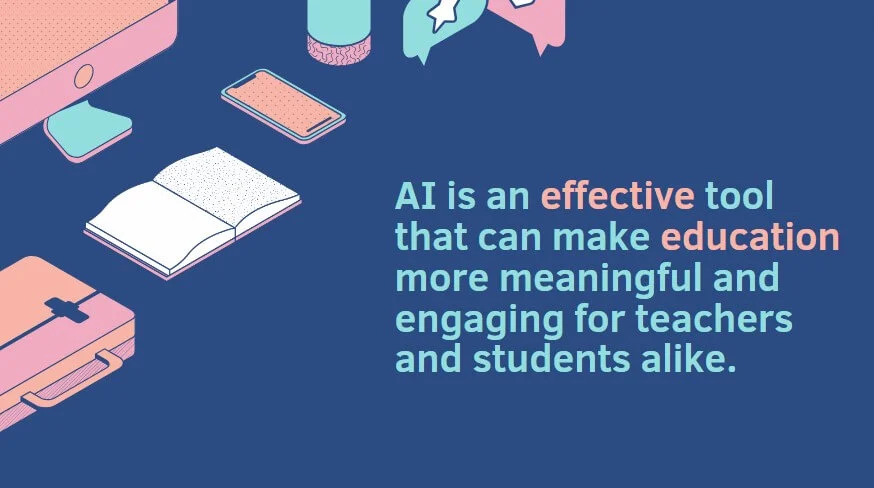The Transformation of Education with AI: A Bright Future with Role of ai in education sector

Role of ai in education sector. Education is a crucial part of everyone’s life, setting the foundation for success. Over time, the world has witnessed continuous changes in the education system, from teaching methods to curriculum design. Amidst these changes, Artificial Intelligence (AI) has emerged as a transformative technology that is revolutionizing various sectors. In this blog, we will explore the impact and applications of AI in education, focusing on how it is changing the way we learn and teach.
What is AI in Education?
AI in education, often referred to as AIED (Artificial Intelligence in Education), is the application of AI technology to enhance teaching and learning experiences. Contrary to the misconception that AI is here to replace human teachers, its primary goal is to assist educators, students, and educational institutions in creating a more efficient and effective learning environment.
Applications of AI in Education | How is AI used in education

- Automating Tedious Tasks
In the education system, teachers spend a significant amount of time on tasks like grading tests and homework, which can be time-consuming and repetitive. AI tools can automate these processes, especially for multiple-choice questions and fill-in-the-blank assessments. While AI is not yet capable of entirely replacing human grading, it is steadily improving. This automation frees up teachers to focus on more interactive and engaging classroom activities.
- AI Tutors for Additional Support
Not all students can grasp concepts easily, and they often need additional support beyond regular classroom hours. AI-driven tutoring programs are designed to provide this support. These programs can help students with foundational subjects like mathematics and writing. While AI tutors are effective for basic concepts, they may not replace the need for human professors when it comes to teaching complex, analytical subjects. However, future advancements in AI could change this dynamic. How is AI used in education
- Providing Feedback
AI is not limited to assisting students; it can also provide valuable feedback to both students and teachers. Online course providers use AI-driven systems to analyze student progress and alert professors to critical performance issues. This immediate feedback helps students identify their mistakes and improve their understanding, rather than waiting for feedback from instructors. Role of ai in education sector
- Identifying Learning Gaps
Identifying gaps in learning can be challenging for teachers due to time constraints. AI-driven programs can help address this issue. For example, when a large number of students submit incorrect answers to a homework assignment, the system can alert the teacher and provide hints to the correct answer. This approach helps fill learning gaps and ensures that each student grasps the concepts effectively. How is AI used in education
- Redefining the Teacher’s Role
Teachers play a critical role in education, but AI can change the nature of their role. AI can automate various tasks such as grading and providing reports. In some cases, AI can even act as a real-time tutor. This shift allows teachers to focus more on facilitating and guiding students, rather than administrative tasks. How is AI used in education
- Personalized Learning
AI’s goal in education is not to replace teachers but to enhance their abilities. AI systems can be programmed to provide personalized learning experiences. By understanding individual students’ needs and learning styles, teachers can create tailored study plans. As AI technology evolves, it may even be possible for machines to detect students’ facial expressions during learning to gauge their comprehension and adjust teaching methods accordingly.
- Generating Smart Content
AI can generate smart content in various ways:
- Digital Lessons: Digital learning has become popular, offering customizable options like e-books, study guides, and bite-sized lessons.
- Information Visualization: AI can visualize information in new and engaging ways, making it easier for students to understand and retain.
- Learning Content Updates: AI can keep learning materials up-to-date and adaptable to different learning curves. How is AI used in education
Ensuring Access for Students with Special Needs
Students with special needs, such as those who are deaf or visually impaired, face unique challenges in education. AI-enabled tools can be trained to interact effectively with these students, providing tailored support.
- Universal Access
AI-powered digital learning offers universal access to study materials. Students can learn at their own pace and convenience, accessing high-quality courses from around the world without leaving their homes.
Benefits of AI for Students

- 24/7 Access to Learning: AI-driven digital learning allows students to study anywhere, anytime, accommodating their individual schedules.
- Better Engagement: Personalized learning and interactive AI-driven programs make studying more engaging and enjoyable. AI in education
- Reduced Pressure: AI-enabled virtual assistants can answer students’ questions without the fear of asking in front of their peers, reducing academic pressure.
The Future of AI in Education
The future of AI in education holds great promise, focusing on three key areas:
- Performance Personalization: As AI technology advances, personalized curricula will become more accessible, offering tailored learning experiences to students. Tools like “Brightspace insights” will help educators track and monitor student progress.
- Bias Elimination: AI will work to eliminate human bias in education, ensuring fair evaluation of work and exams using established criteria.
- Combined Assistance: AI-powered smart classrooms will assist teachers in administrative tasks, allowing them to focus on their core teaching responsibilities. Role of ai in education sector
Several AI challenge in the education sector:
- Data Privacy and Security: Safeguarding sensitive student data and maintaining privacy is a significant concern. AI Challenge
- Bias and Fairness: Ensuring AI systems are free from bias and provide fair opportunities for all students is crucial.
- Teacher Training: Educating teachers in effectively integrating AI tools into their classrooms can be challenging.
- Infrastructure and Access: Many educational institutions lack the necessary infrastructure and access to implement AI technologies.
- Customization: Tailoring AI solutions to meet the unique needs of individual students can be complex. AI in education
- Cost and Funding: Implementing AI in education can be expensive, and securing funding can be a hurdle. AI challenge
- Ethical Considerations: Addressing ethical dilemmas related to AI, such as AI-generated content, is a growing concern. AI challenge
- Data Quality: Ensuring the accuracy and reliability of the data used to train AI systems is vital for their effectiveness in education. Role of ai in education sector
These challenges must be carefully addressed to fully harness the potential of AI in education.
Conclusion

Artificial Intelligence is gradually transforming the education sector, offering support to both teachers and students. While AI is not yet fully adopted by all educational institutions, its potential impact is undeniable. The future of AI in education promises to create a more personalized and engaging learning environment. It is important to remember that AI is not intended to replace human educators but to enhance their capabilities. As AI continues to evolve, its role in education will become increasingly important, helping shape the future of learning. Role of ai in education sector
In summary, AI in education is not just a technological advancement; it is a tool that has the potential to revolutionize the way we learn and teach, making education more accessible, engaging, and effective for everyone. AI in education
Read More
- What is Deepfake AI | Is Deepfake legal in India
- How AI can helpful at Ram Mandir Ayodhya Safety on January 22, 2024
- How Infosys loses $1.5 billion AI contract from global customer
- What is RAG Model ? How does rag work ? Future of Technology
- What is LLM large language model | Important LLM’s in 2023
- What happens if you go on the dark web | Is dark web illegal in India 2023?










0 Comments